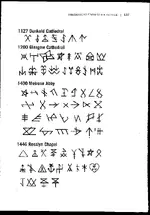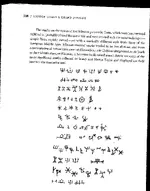Ground0
Jr. Member
So this would indicate ESE...and then a measure of distance? Thanx, I'm glad this topic came up and it's a GREAT thread!!!
You might try 300 varas or three leagues, depending upon the terrain.Ground0 said:So this would indicate ESE...and then a measure of distance? Thanx, I'm glad this topic came up and it's a GREAT thread!!!
Shortstack said:Ground0:
You say this bridge was in the middle of town and the marked stones were underwater. Hmmmmm. Let me throw one more curve ball. Those marks MIGHT be nothing more than mason's marks used to identify the mason or masons' group that were building the stone base of this bridge. I looked up some mason's marks in a book titled, Hidden Codes & Grand Designs, by Pierre Berloquin and found one of the marks used on the 1446 Rosslyn Chapel in Scotland was a simple equilateral triangle. Does this mean that these marks you've found ARE only mason marks for workers pay verification?? No, not necessarily. This is just one more thing to take into consideration; one more thing to prove or disprove in your search. When was that mill dam built in relationship to the construction year of the bridge?
The number of different groups who hid things around the country and their particular designs for code markers is daunting, so the need to weed out those who were not involved with a particular trail is just as important as figuring out who WAS. Log in these bridge marks and expand your search out from here; looking for other marks and symbols that might tie in with these. Are there any marks in the stones of the mill dam?


desertmoons said:Hmmmm maybe i will get back there and see what direction the arrow is pointing at . I was looking for something else and just snapped that at the end of a long hike.. But the negative sure makes a girl think a bit.
Thanks ss and Thom.... could be related to a possible map there or could be related to depth I'm guessing.
